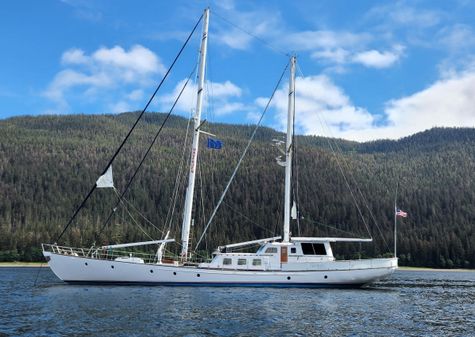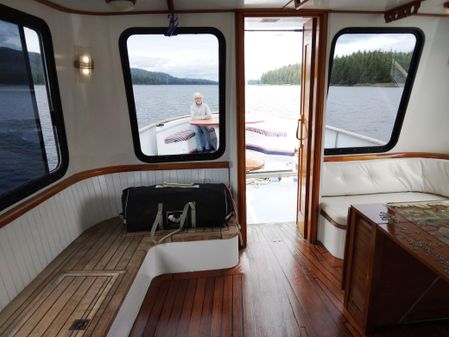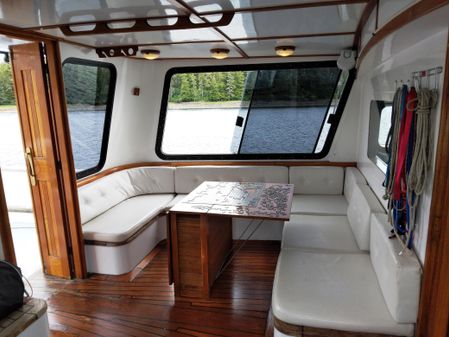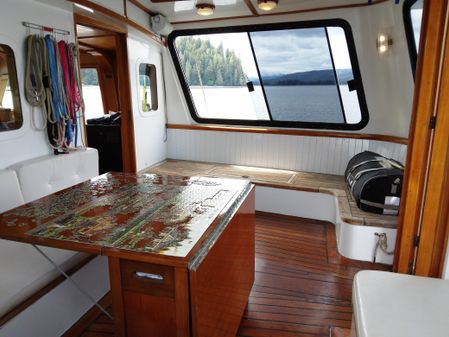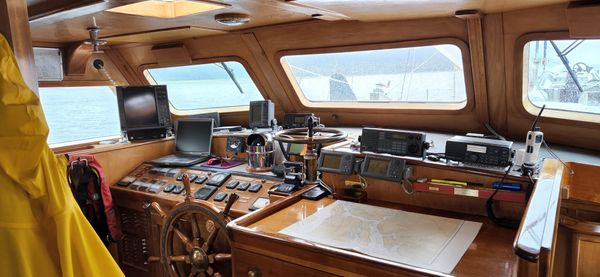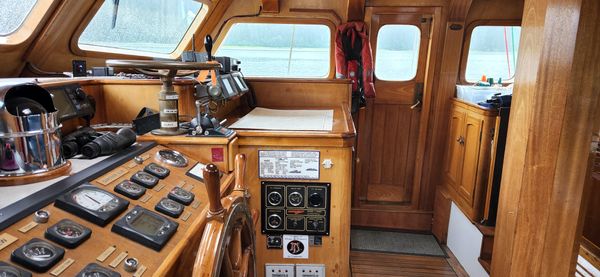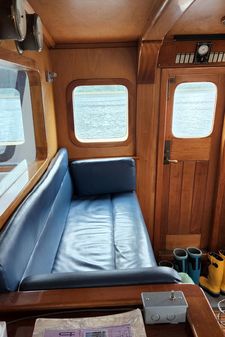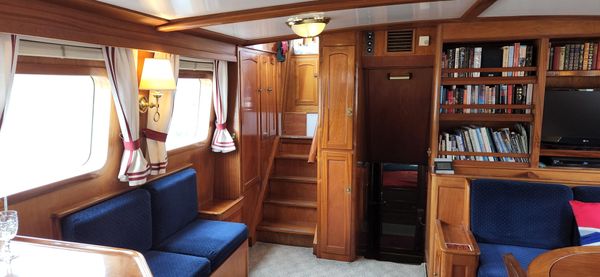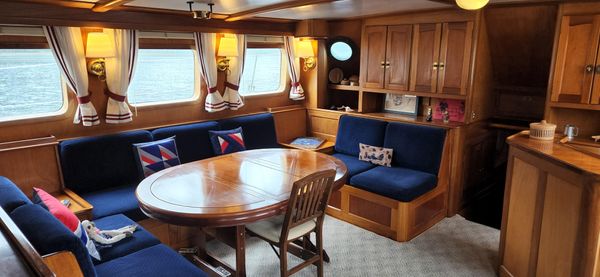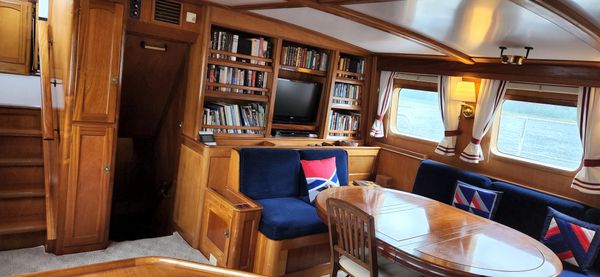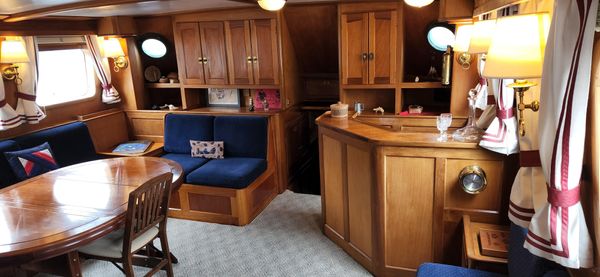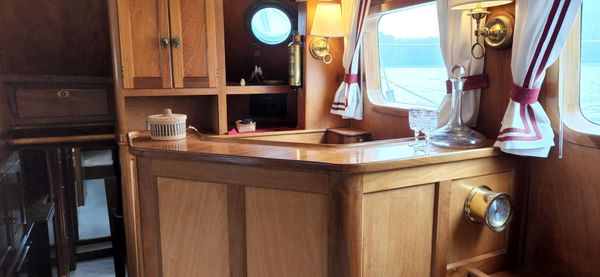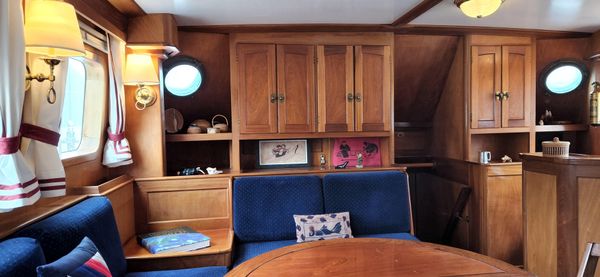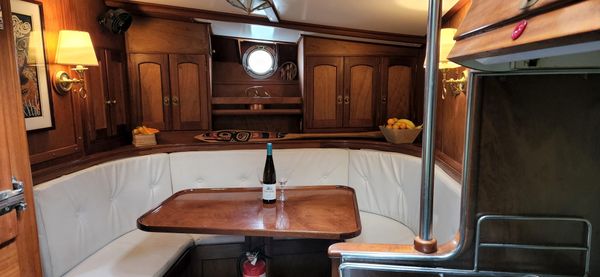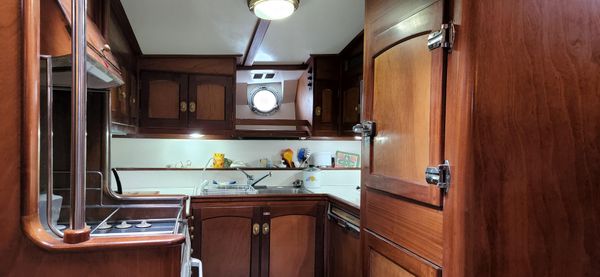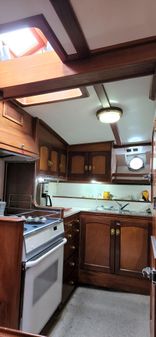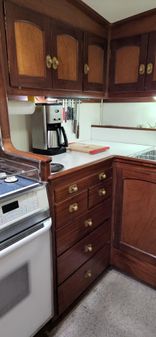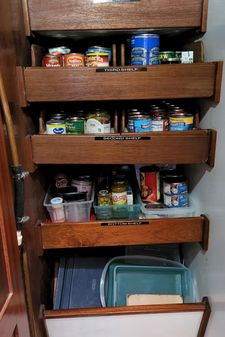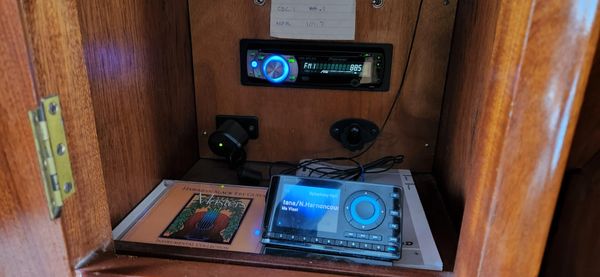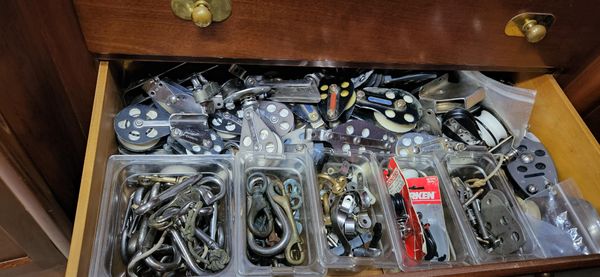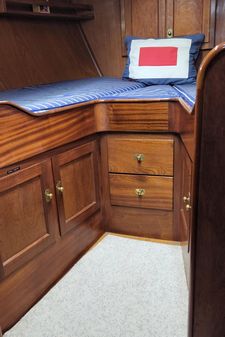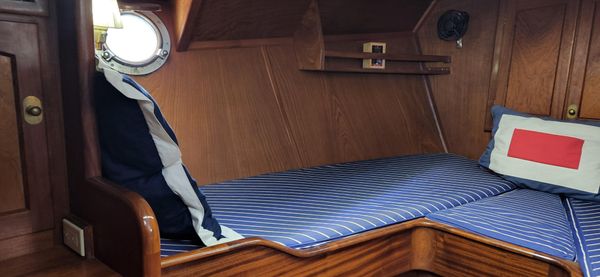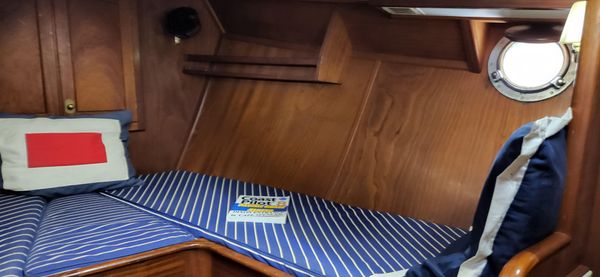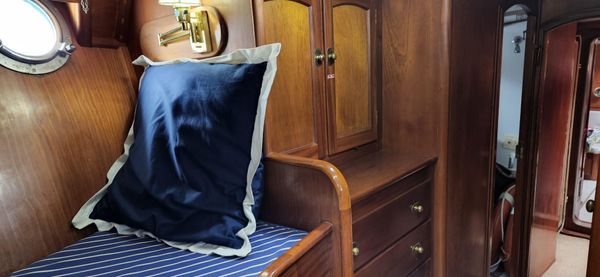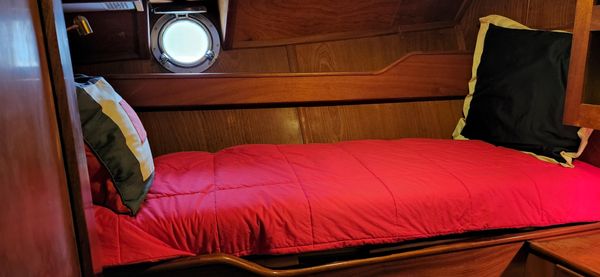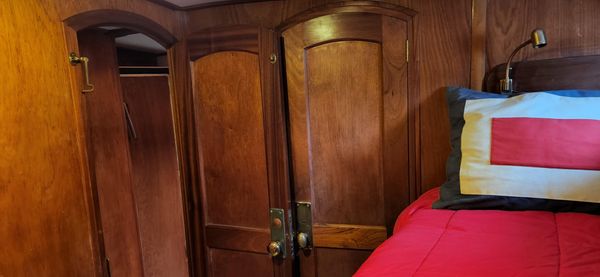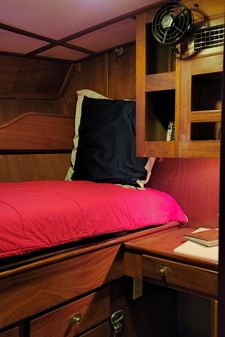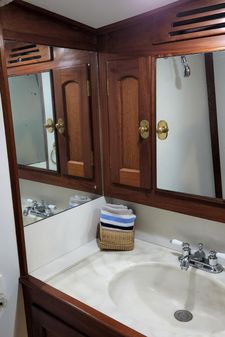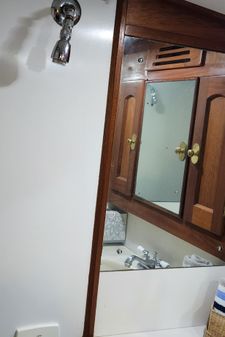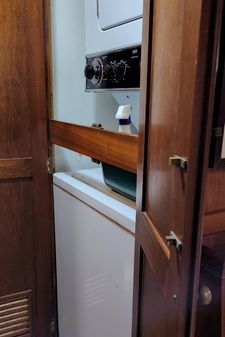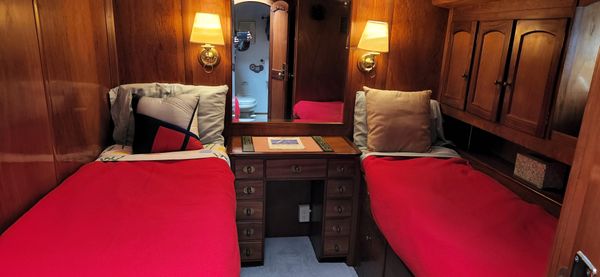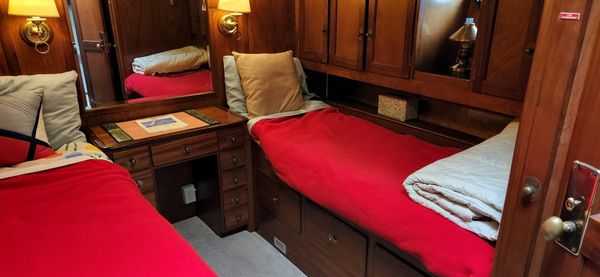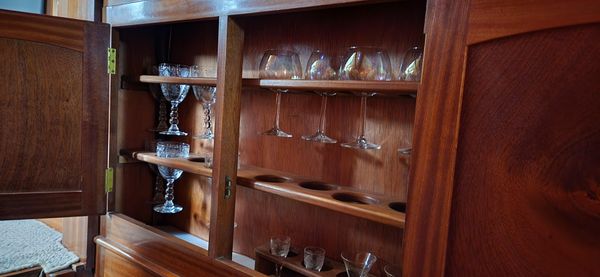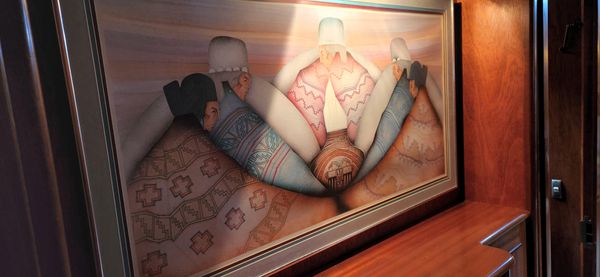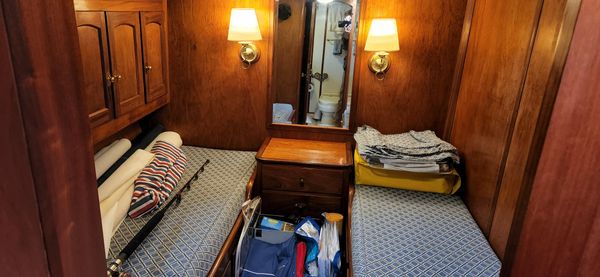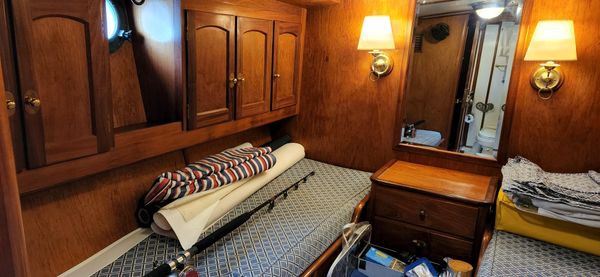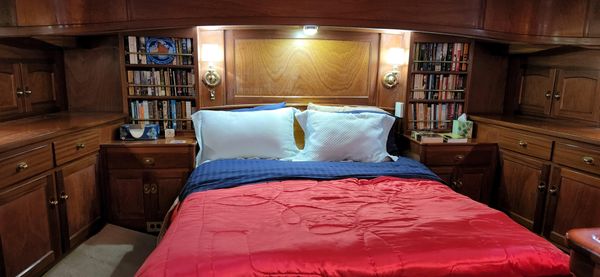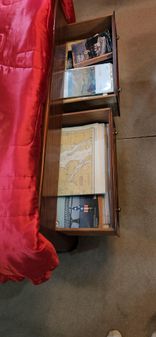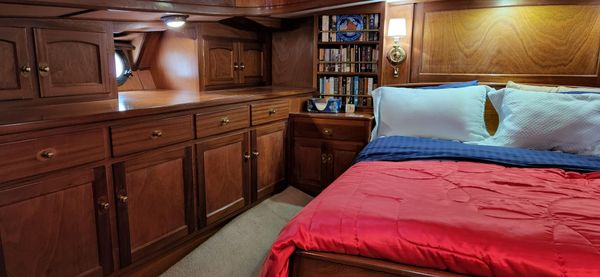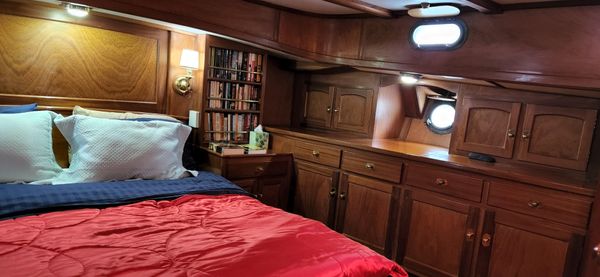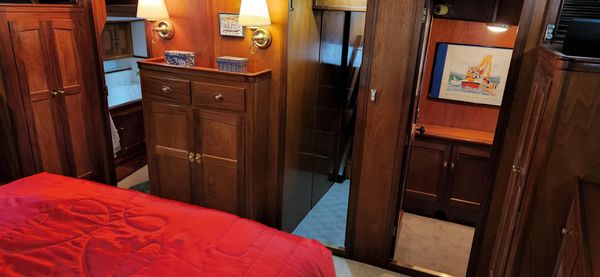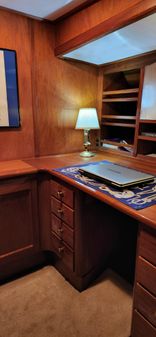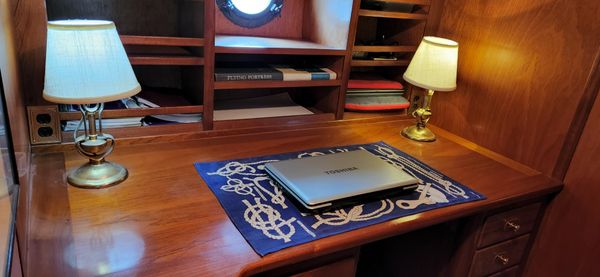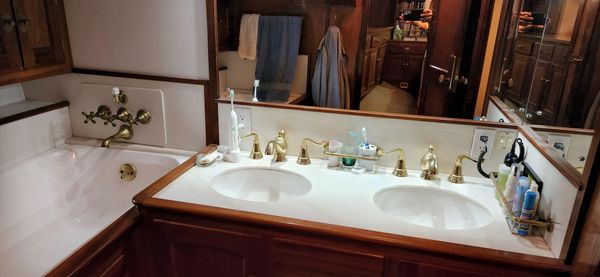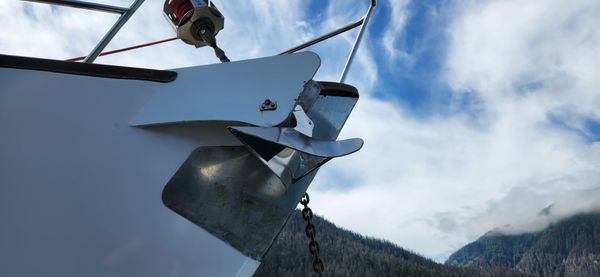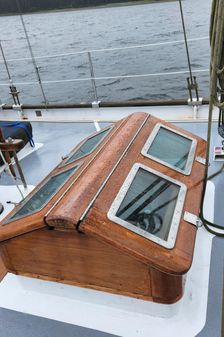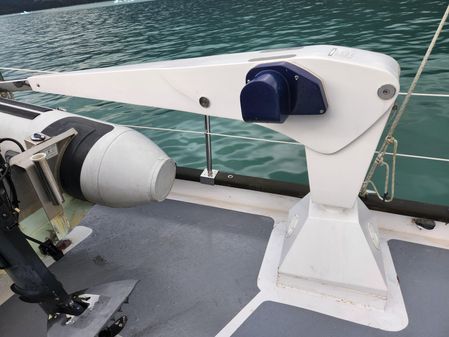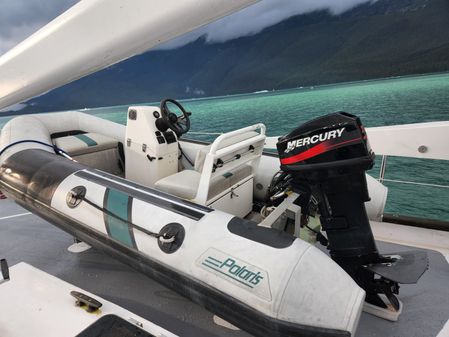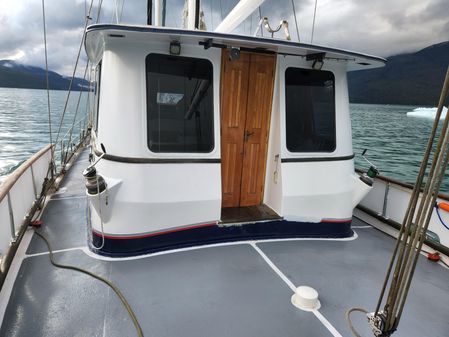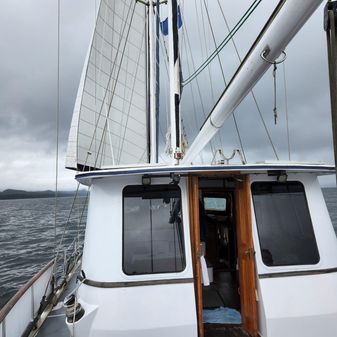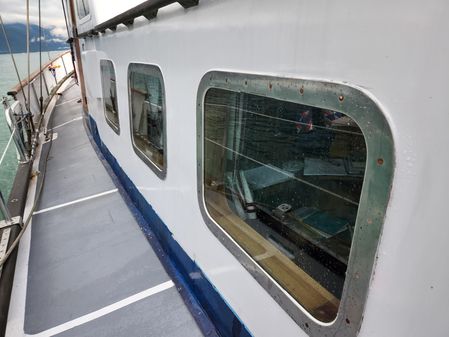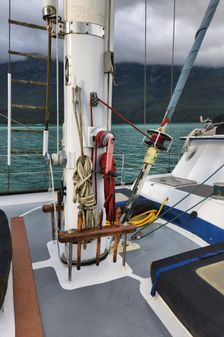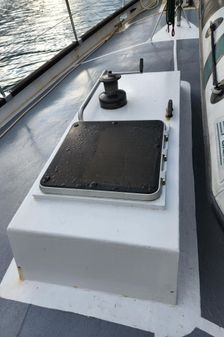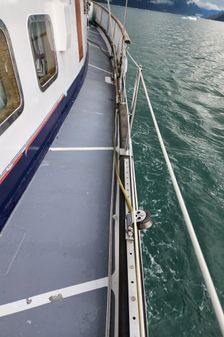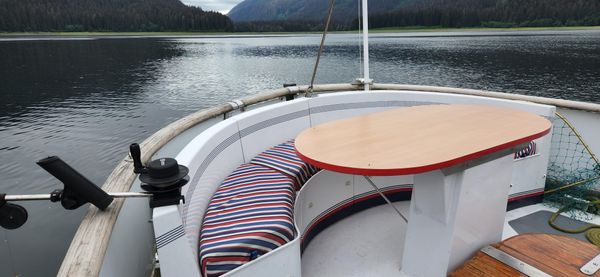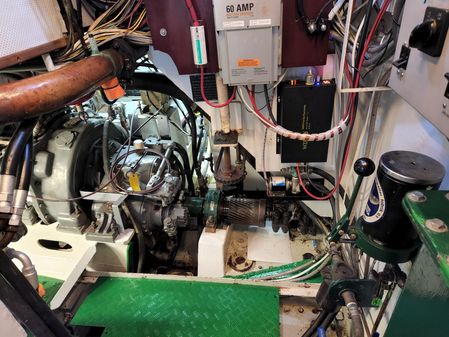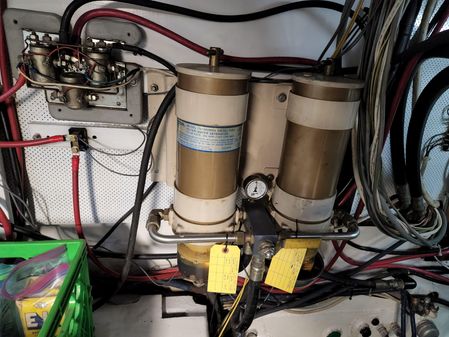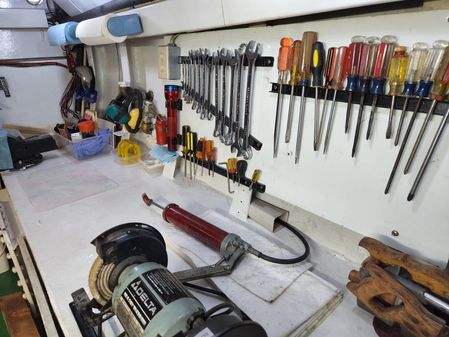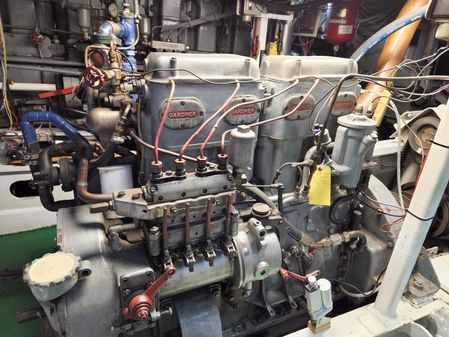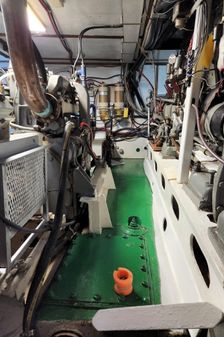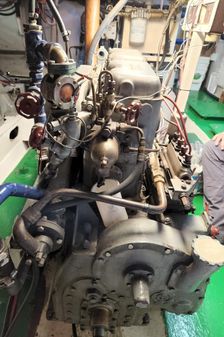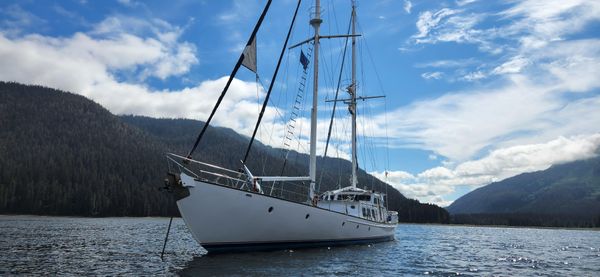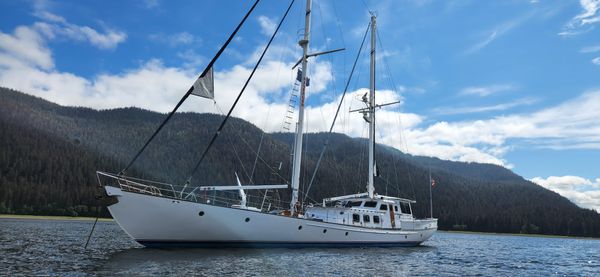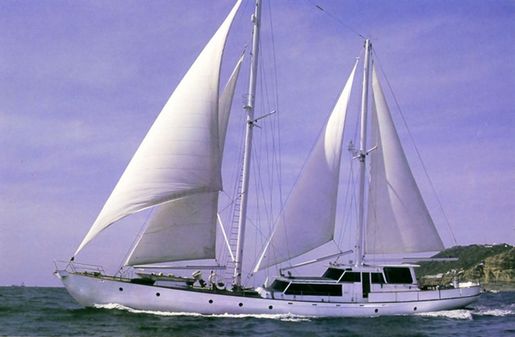Basic Boat Info
Dimensions
Engines / Speed
- Make: Gardner
- Model: 8L3B
- Fuel: Diesel
- Engine Power: 200hp
- Type: Inboard
- Engine Hours: 12,570
Tanks
Other
Contact
Office
Chuck Hovey Yachts, LLC
Seattle, WA, US, 98109
Tel:206-624-1908
Virtually all of the interior is done in a beautiful south pacific wood named Vesi, sometimes referred to as Fijian teak. The wood is rare today and, like New Zealand's Kauri, has been outlawed to cut for decades. Vesi is now being farmed but will take time to grow. The joinery is excellent, and the wood is in excellent condition and beautiful. Most of the interior has great head clearance and 6 footers will like it. Most of the floors are carpet, many with teak or vesi floors beneath.
The gorgeous owner's cabin is aft, full width of the hull so it easily accommodates the centerline, standard queen size bed. Aft of the saloon and beneath the sundeck, it offers excellent privacy. There are twin closets and lots of built-in cabinetry. Port-side is a head with twin lavatories, Master flush toilet, shower and a tub. Starboard-side is an office with built- in desk and swinging lamps.
Above the aft stateroom and aft of the pilothouse is a sundeck. It is a fully enclosed area with big windows, seating and a fold-up table. It sits high above the owners' cabin and is a wonderful space to hang out. It's excellent for Alaska as it is tightly enclosed and also very cozy for Mexico with the big windows open. Also can be used it for a napping area for night crossings so the helm person can easily rouse another. A major asset for the boat.
The saloon, forward and stepped down from the pilothouse, is large and comfortable with seating wrapped around a Chinese cherry table. There is a bar in one corner. A 32-inch flat screen is located amid a library area at the aft bulkhead. The sound system has 4 zones and is set up for Sirius/XM radio. The saloon has 6 big windows with blinds and curtains and is very bright.
Forward of the saloon are two twin guest cabins. Both are ensuite with sink, head and shower. All done in vesi. Because the guest cabins are separated from the owner's stateroom by the saloon, the privacy level aboard Havfruen is excellent.
Next is the galley which is close to midships and easy to work in. The stove is electric and requires A.C. power to use. A large (electrically actuated) butterfly hatch provides ventilation. The galley features a double sink, microwave, good lighting, and dishwasher (never used & now disconnected).
There is a large cold plate type refrigerator with a top quality Grunert compressor system. Two Norcold top-load coolers are aboard for energy efficient freezing and refrigerating. There is also a gigantic cold plate freezer for packing away a couple of deer or a moose. Or beverages.
Adjoining the galley is a very pretty and convenient dinette with storage beneath. Forward of the galley to port is the gigantic freezer, starboard is a stacked washer (currently in-op) and dryer.
Forward of the galley area, the boat is separated by a heavy watertight door. This bulkhead demarks a separation between owner territory and crew territory. Crew quarters consist of a separate cabin for a captain and a large V-berth for one or two hands. Both these cabins are finished in vesi and feature a full head with sink, toilet, and shower.
The crew area contains a deck hatch so crew personnel can get outside without going through the rest of the boat. It also contains a very large pantry which is wonderful for long distance use. With lots of fuel, lots of water, and lots of food, Havfruen is well setup for very, very long-distance travel.
Forward of the V-berth is the anchor locker. The locker is contained behind a heavy steel door, bolted to the bulkhead. Forward bulkhead is designed to be a crash-proof bulkhead. Much of the steel at the prow of the boat appears to be stainless.
The hull is 1/4 inch steel, round chine and very fair. Decks are 3/16 steel. The keel is long and shallow draft, built for the shallow South Seas waters. The bottom of the keel is about 3 feet wide and flat. In the middle of the keel is a swing keel, a 20 foot long, 3 inch thick steel plate which, when dropped, adds 4 feet to the draft. The swing keel is actuated with a manual hydraulic pump. The hourglass stern is mostly round, very fair, and swept up close to deck high.
The rudder is mounted on a sturdy, steel gudgeon and is well protected as is the propeller.
The hull was sandblasted and coated – very competently – 6 years ago. The base coat is PPG's Amercoat epoxy. The bottom paint is Amercoat ABC #3.
Havfruen is a cutter rigged ketch with an unusual rig: Instead of a mainsail, the boat carries a mizzen staysail – basically a jib set from the mizzen mast. This is a system seen only in big cruising sailboats. The no-mainsail setup makes the boat much, much easier to handle but it is at the cost of upwind performance.
Spars and rigging are extra-stout, built for cruising durability and strength, rather than for performance sailing. Masts are relatively large cross section and thickness, wire is 5/8, most connections are 1 inch pin. The jib is mounted on a Hutton manual furler with the furling line led to the electric windlass. Jib sheets are handled on two big Barient elecric winches located on the aft deck. The staysail is mounted on a Profurl furler with the furling line led to either the electric winch or a manual 3 speed Lewmar, whichever is more convenient in the circumstances. The staysail is club-footed on a heavy-duty boom and its outhaul is handled the same way as its furling line. The staysail sheet is triangulated rather than travellered. The mizzen staysail is mounted on a Shaeffer furler with the furling line brought in on a Lewmar ST winch and the outhaul handled by the electric capstan located atop the forward lazarette. The mizzen is both furled and out hauled on a Maxwell ST winch.
The jib, staysail and mizzen are each about 12 years old and in good condition. The mizzen staysail is older, we think 20 years, and looks it. Amazingly, it is actually a very good sail and just keeps going. Lines are mostly pretty new. Most of the standing rig was replaced about 14 years ago (quite un-necessarily). It's a very stout rig with 5/8 wire and 1-inch pins.
Havfruen is powered by a single, venerable Gardner 8L3B, the last and best diesel engine made by Gardner. The reversing gear is a Twin Disc 2:1 reduction driving a 3-inch shaft. The propeller system is a Hundested variable pitch 4 blade propeller, all the best of the day.
The engine is huge (7,000 pounds) but delivers just 200 HP at a max rpm of 1200. It idles at 300 RPM and is usually run at around 750. By today's standards it is pretty unsophisticated – no turbo, no emission controls, no electronics. This engine is generally regarded as good for 20,000 hours to rebuild time. The engine is very quiet (because of the super heavy case and low RPM).
The engine is naturally aspirated and English-built. Injectors were rebuilt a few years ago and compression checked. Each cylinder has an individual head making getting to key components from above the engine easy. The saloon floor has a big hatch for engine access. Also, the case has large access plates on both sides for each cylinder.
Havfruen is usually cruised at 6 to 7 knots burning about 2.5 gallons per hour – including fuel for generator use and diesel heat.
The engine controls include a pyrometer for measuring engine exhaust temperature, the best indication of how much the engine is loaded. The pyrometer is key to operating this engine well. Engine controller is a Kobelt servo. Shutoffs are electric servos, no cables.
The variable pitch Hundested propeller is set up to be variable from zero to 90 degrees. (It was built such that it could also be set to run from +45 degrees to -45 degrees, eliminating the need for a reversing gear). The Hundested was removed about 5 years ago for inspection. All the bearings and seals were replaced, the shaft confirmed straight and then aligned upon reinstallation.
Fuel is contained in 5 connected tanks, all located in the engine room. Total capacity is about 1750 gallons. At 7 knots, 2.5 gallons per hour, that's approximately 5,000 nautical miles. Tanks are isolatable with gate valves (recently serviced). Fuel is delivered first to a 150-gallon day tank, pumped through a pair of big Racor-type filters. From the day tank, fuel is pumped through another pair of un-necessarily big Racors to the engine.
Oil changes are easy with an electric oil change pump. The big Gardner takes 10 gallons of lube oil.
The engine exhaust is dry and exhausted at the transom. There is a water jacket along the exhaust pipe. Seawater is pumped (electric pump) through the water jacket to cool the exhaust. This eliminates the risk of flooding the engine by inadvertently overfilling a water-lift muffler.
Engine cooling is a keel cooler system using anti-freeze. The keel cooler is a triangular channel integrated along the hull. It's located along where the round part of the hull meets the vertical wall of the wide keel. A surge tank shows the head of the anti-freeze.
Wesmar 25 HP hydraulic bow thruster. The hydraulic pump is belt-drive by the 4-cylinder Gardner 4L. The hoses run overhead through the engine room and under the floor forward of the engine room. The equipment is solid and reliable. The 4L, unlike the main engine, is noisy. Just like the main engine, the exhaust is dry with a water jacket exhausted out the transom.
Currently, there is a single steering station in the pilothouse. We usually steer with the autopilot, a Simrad AP20 with an electronic heading reference driving a pair of AccuSteer reversible pumps. The pumps are redundant and can be run singly or together. We find one is quite adequate. It is also possible to switch the steering to a joystick system for manual control without leaving the pilothouse seating bench. There is also a classic spoked wheel driving a Robertson hydraulic pump.
The diameter of the hydraulic cylinder is 2.5 inches. Originally, there were 2 steering stations, the second one was located near the rear of the aft cockpit. We took it out because it was an unnecessary complication, it was very difficult to see anything from back there and because it was a wonderful spot to locate a very nice dining/conversation area. The old binnacle now supports a lovely maple table.
As a consequence of the change, the spares now include an extra steering pump and engine controls.
Havfruen runs on 4 electric systems: 12 and 24 volt DC, 110 and 220 volt AC.
The primary power is 24 volt delivered from a bank of 8 lead-acid batteries located forward in the engine room. The anchor windlass is powered by its own bank of 2 batteries located in a V-berth locker, and the big electric sheet winches run on a bank of 2 batteries located in the aft lazarette. All the batteries are charged with an 80 amp Charles 3-stage, 220v charger or with the 150 amp alternator running off the 8L3B which charges only the main bank. There are 2 large solar panels on the roof. They are a significant source of amps in Mexico.
Some electronics and a few lights are 12 volt. 12 volt juice is supplied by a 24 to 12 voltage converter in order to avoid another battery set-up.
The main engine alternator is a 150 amp high quality Leece/Neville alternator, externally regulated with a Balmar adjustable regulator. There are 2 spare alternators hidden away that you will never need.
AC power can be supplied by shore power, by a 7,500- watt Northern Lights generator, by a 20,000 watt generator driven by a 4 cylinder Gardner 4LW, or by a 3,000 watt true sine inverter which delivers 110v.
The Northern Lights generator is enclosed in a sound shield box. (3350 hours July 2022). It is keel cooled and dry exhausted through the side of the boat. Fuel is from the day tank.
The 20,000 watt generator, powered by the 4 cylinder Gardner, runs the hydraulic bow thruster. It could be used to power new owners HVAC, if desired.
All lighting is LED now and the lighting electric load is tiny. Most of the boat has been re-wired, modernizing circuits and changing cable to modern marine grade wire.
Shore power is hard-wired. Isolation transformers supply both 110 and 220 voltages.
Starters: The main engine has 2 identical redundant 24vdc starters, one port side, one starboard. We had both serviced 10 years ago. We have replaced the original series circuit Lucas solenoid with parallel wired solenoids so that the starter can be selected with a simple toggle switch. Now, a starter can be removed for servicing without shutting down the boat. One starter is plenty sufficient to start the engine and these starters are still available.
For a main anchor, Havfruen carries a 200# Danforth on 350 feet of 5/8 BBB chain on the port side. The starboard anchor is a 60# SS articulated plow “lunch hook” on 400 feet of 3/8 BBB.
Anchor windlass power is supplied by a pair of group 29 batteries located in the V-berth which is plenty sufficient for multiple anchor retrievals. Charging current is from the engine room Charles charger.
The anchor windlass is a 24 vdc Francis (later bought out by Lewmar) 2000 with 2 horizontal chainwheels and rope capstans. The windlass is an oldie but goodie with plenty of power. It was disassembled for inspection 3 years ago, the main shaft bearing was replaced and improved. It was also converted to single speed to be more reliable. Retrieval speed is about 30 feet per minute.
A spare 200# Danforth is in remote storage.
There is a convenient, low-tech tie-back system to secure the main anchor.
The dinghy is a Canadian built Polaris inflatable with a 25hp Mercury outboard. Polaris builds boats for the Canadian Coast Guard.
The boat is stored on the foredeck and easily launched with a Jackson 800# hydraulic/electric crane. The crane has been remounted so it swings easily, and the electric winch has been recently replaced and – this time – protected from the weather.
- 2) Radars, one is big CRT Furuno and the other a digital Nobeltec (koden)
- (2) Independent GPS - Furuno GP32
- (2) VHFs
- (1) HF radio ICOM 800
- Nobeltec on a laptop interfaces with Nobeltec radar
- Depthsounder - Furuno LS6100
- EPIRB
- Garman Viking valise liferaft
Fresh water is supplied from 2 integral tanks of about 650 gallons each. There are 2 electric potable water pumps, one for each tank. Switching is achieved with simple toggle switches (port, stbd or both). Pumps and tanks are easily swapped so the system is redundant and not dependent on a single pump.
All water is wasted to one of two holding tanks, each about 300 gallons. There are no underwater thru-hulls. All seawater is supplied from a seachest.
4 Toilets are Vacuflush. Owner's cabin toilet is a Masterflush. All are supplied with fresh water.
Hot water is from a 10-gallon electric water heater.
- Large plumbing department including approximately 20 spare pumps
- Large electric department, tools, wire, connectors, spare Simrad autopilot, meters, breakers, switches and more
- About 200# of fasteners, all stainless
- Painting supplies – brushes, epoxies, sanders
- Complete sets of hand tools, wrenches in Sae, metric, witworth
- Extensive power tool collection
- Multiple extra winches, sailing hardware
- Professional grade ultrasonic thickness gauge
- Miscellaneous Gardner parts including a spare injector set
- Several spare alternators
- Spare steering pump, Kobelt engine control station
- Filters, additives, oil blankets and more
- Multiple fishing poles, reels and lures
- Huge watermaker in storage
- RDF weatherfax in storage
- Honda gasoline emergency pump
- Lots of spare line
Gorgeous, classic, private interior combined with safe, easy double-handed sailing in a tough long-range cruiser.
The exceptionally lovely interior aboard Havfruen belies her salty pedigree and globe-girdling history. Her keel was laid in 1978 and the yacht was completed and delivered for her first owners in 1983.She is set for safe, easy sailing and is currently sailed doublehanded by her owners who have cruised summers in Alaska over the last decades. She is tough and durable with a Gardner diesel providing long range under power. The layout offers a gracious and private full beam owner’s cabin with walk-around bed plus four additional private cabins. Charterers, family cruisers, and double- handed sailors who wish to enjoy spacious and gracious cruising will all appreciate what Havfruen delivers. Extensively updated and well-maintained.
Wrangell is accessible by daily Alaska Airlines flight from Seattle. It is even possible to do the round trip in one day, as the airplane goes to Anchorage and then turns around to stop southbound in Wrangell, allowing about 3.5 hours on the ground.
All personal gear and Alaska art objects. Artwork; loose items; galley gear; CD's; clock & barometer sets; charts; fishing equipment; tools; spare parts; supplies & items not specifically listed on equipment list specifications sheet.
Contact Martha Comfort at 206-624-1908 or 206-499-0910 (cell) for additional information and your viewing appointment.
